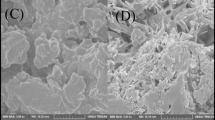Abstract
The use of polyurethane foam appears to be efficient to extract hydrophobic pollutants from aqueous media. Their adsorption is the result of spontaneous hydrophobic interactions with the foam. The rate of adsorption is a function of the diffusion of the molecules into the foam as well as their hydrophilic/lipophilic balance. A mixture of different molecules modifies the adsorption capacities of each type of molecule on the foam, probably resulting from stacking phenomena between the molecules. The Pseudomonas species can grow in the presence of the polyurethane foam and be adsorbed on it. Moreover, a strain of Pseudomonas pseudoalcaligenes, tested in this study, can use adsorbed biphenyl as the sole carbon source. Polyurethane foam therefore shows favorable characteristic for being chosen as a method of concentrating aromatic compounds and optimizing the rate of degradation of these molecules by bacteria.
Similar content being viewed by others
References
Cseh T, Sanschagrin S, Hawari J, Samson R (1989) Adsorption-desorption characteristics of polychlorinated biphenyls on various polymers commonly found in laboratories. Appl. Environ Microbiol 55:3150–3154
Furukawa K, Miyazaki T (1986) Cloning a gene cluster encoding biphenyl and chlorobiphenyl degradation in Pseudomonas pseudoalcaligenes. J Bacteriol 166:392–398
Furukawa K, Suzuki H (1988) Gene manipulations of catabolic intermediates of various biphenyl compounds. Appl Microbiol Biotechnol 29:363–369
Furukawa K, Simon JR, Chakrabarty AM (1983) Common induction and regulation of biphenyl, xylene/toluene, and salicylate catabolism in Pseudomonas paucimobilis. J Bacteriol 154:1356–1362
Fusee M, Swann WE, Calton GJ (1981) Immobilization of Escherichia coli cells containing aspartase activity with polyurethane and its application for L aspartic acid production. Appl Environ Microbiol 42:672–676
Helenius A, Simons K (1975) Solubilization of membranes by detergents. Biochim Biophys Acta 415:29–79
Meer JR van der (1994) Genetic adaptation of bacteria to chlorinated aromatic compounds. FEMS Microbiol Rev 15:239–249
O'Reilly KT, Crawford RL (1989) Degradation of pentachlorophenol by polyurethane-immobilized Flavobacterium cells. Appl Environ Microbiol 55:2113–2118
Sanroman A, Pintado J, Lema JM (1994) A comparison of two techniques (adsorption and entrapment) for immobilization of Aspergillus niger in polyurethane foam. Biotechnol Tech 8:389–394
Vorlop KD, Muscat A, Beyersdorf J (1992) Entrapment of microbial cells within polyurethane hydrogel beads with the advantage of low toxicity. Biotechnol Tech 6:483–488
Ying W, Saojka SA (1986) US patent 4 623 464, November 1986
Author information
Authors and Affiliations
Rights and permissions
About this article
Cite this article
Enkiri, F., Hulen, C. & Legault-Demare, J. Hydrophobic adsorption of aromatic compounds on polyurethane foam as carbon source for Pseudomonas growth. Appl Microbiol Biotechnol 44, 539–545 (1995). https://doi.org/10.1007/BF00169957
Received:
Revised:
Accepted:
Issue Date:
DOI: https://doi.org/10.1007/BF00169957




